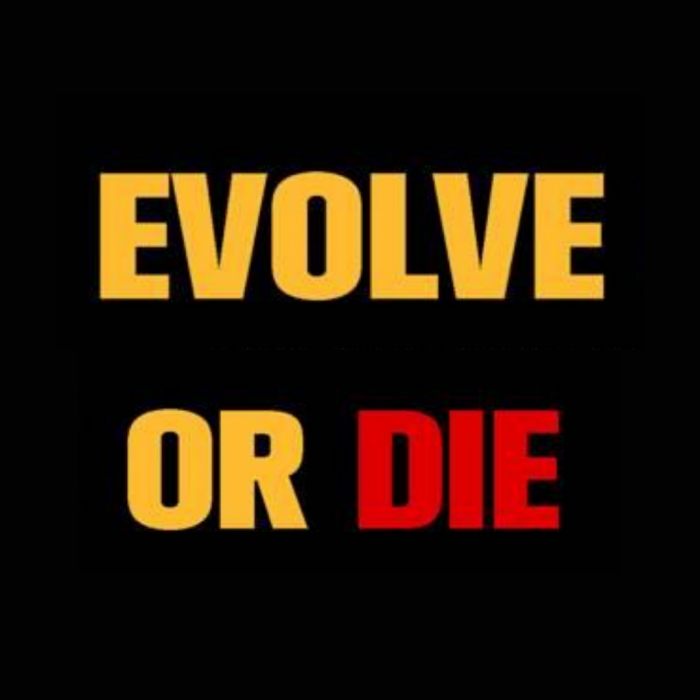
Welcome to the Evolve or Die course
A short course designed to go hand in hand with the self-development book Evolve or Die: 10 simple steps to take your business, or yourself, to the next level.
This course is an online accompaniment to the Evolve or Die book, which you’ll receive when you sign up for the course; it’ll walk you through the book’s chapters, offering guidance and examples to help you complete each chapter.
The book and course are designed to help you take control of change: to set goals, work out where you’d like your business or life to be and how to get there.
Introduction and Chapter 1: Why Did You Buy This Book and Course?
Thanks for joining me on the Evolve or Die online course. In this video we’ll look at a bit of background to the course and what you can hope you get out of it. The Evolve or Die course is designed to help you adapt to and plan for change, to set goals, and become the best version of yourself.
Chapter 2: What Don’t You Want?
In this chapter, we’ll look at what you don’t want – what you want to move away from, whether that’s in your personal life or in your business or professional life.
Chapter 3: What Do You Want Instead?
Next, we’re going to focus on what you want instead – where do you want to be in your personal life? Where do you want your business to be in a year?
Chapter 4: What Are You Afraid Of?
Any change is going to have an element of fear to it: moving towards change can be scary and we might feel hesitant. Gaining awareness of what it is you’re afraid of can help you face up to it, address it and keep moving towards your goal.
Chapter 5: Do You Have the Right People?
This chapter is all about people: do you have the right team around you to get where you’d like to be? We’ll look at how you can ensure you’re surrounded by a strong support network, and how to ask for help when you need it.
Chapter 6: What Happens If You Do Nothing?
You’ve worked out what you don’t want, and what you do want. Now we’ll look at what happens if you don’t go ahead with your plans: what are the consequences of inaction?
Chapter 7: What Could Possibly Go Wrong?
In this chapter, we’re asking the question: what could go wrong? Thinking carefully about the risks you might face will help you plan for every eventuality, so that you’re not held back by hurdles or challenges when they come along.
Chapter 8: What Are You Going To Do?
This chapter is all about the actions you’re going to take to achieve the goals you’ve set. What steps are you going to take to get to where you want to be? I’ll give you a useful exercise that helps with this planning section.
Chapter 9: By When?
It’s really important to put a deadline to any project or goal, so that you’ve got something to work towards and to prevent you from putting off the work that needs to be done. Make it specific, and stick to it. We’ll also look at combining this chapter with the planning exercise in Chapter 7.
Chapter 10: The Summary
In the final chapter, we’ll look over the goal you’ve set, and the process you’ve set to help you achieve it. This chapter is about solidifying what you’ve learned, and setting it down in a way that’s going to be useful to you, so that you stick to your plan.
Next steps
If you’d like to go more in-depth and learn to change your behaviour to get the most out of your life, or work towards big personal or professional goals, have a look at the NLP Business Practitioner course. The Business Practitioner is a group course that runs over 10 two-hour sessions, and will help you understand the way you and others think and behave, so you can get the most out of every interaction.

Welcome to the NLP Core Skills Course
An introduction to Neuro-Linguistic Programming: what it is, and how it can help you succeed in every area of your life.
NLP is an approach to communication that involves modelling great communicators, and analysing the way that you and other think and behave, so that you can get the most out of every interaction. This Core Skills course will give you an overview of NLP, along with some useful tools and techniques you can put into action right away to start achieving your goals.
If you’d like to get better at staying calm and managing stress, try our Stress Management Toolkit.
Introduction
Thanks for joining me on The NLP Core Skills course. You’ve probably heard about NLP in the past, and maybe you want to learn more about it: this course will give you a good grounding. We take a pragmatic, practical view of NLP, that is designed to give you useful tools to help you get the most out of your life.
What is NLP?
An overview of NLP: what it is, how it can help you, and some of the history. Essentially, it’s all about communication; analysing the way you and others think and communicate so you can become a persuasive and confident communicator.
Conscious and Unconscious
In this chapter we’re going to be looking at the unconscious and conscious mind, and how you can use these concepts to access the way your mind works at an unconscious level, and to control things (like your stress response) that you might have previously thought were outside your control.
Understanding Perception and Reality
Next, we’re going to look at the difference between perception and reality. Have you ever noticed that people interpret the same situation in different ways? We’ll look at why, and how this understanding can help you gain empathy and understand the way other people think – so you can better negotiate, engage with them, persuade and entertain them.
Beliefs and Behaviours
In this chapter we’re looking at the belief systems loop, and how changing your behaviour can change the results you get.
Effective Communication
The way we communicate with people can dramatically affect the way the message is received. This session will look at what makes effective communication, the how to achieve it, from the words you use, your tone of voice, to non-verbal communication.
Rapport
In this session we’re going to talk about rapport, a crucial element of good communication. Building rapport with others is critical to getting them on your side, whether you’re delivering a presentation, working in sales, marketing, HR, or any job where you need to work with, get along with or persuade other people.
Representational Systems
Representational systems are the way we interpret the world and our experiences inside our head: you remember the way a memory felt, smelled, looked or sounded. When you can work out other people’s representational systems, you can find the best way to communicate them using their rep system.
Next steps
Now that you’ve completed the NLP Core Skills course, you should have a good understanding of NLP and how you can make it work for you. If you’d like to gain a deeper understanding of NLP and learn some more advanced techniques, have a look at our Personal Development courses, or consider joining our face-to-face online NLP Business Practitioner course [LINK].

Welcome to the Presenter’s Toolkit
A short, focused course designed to help you become a great presenter.
Good presentation skills are essential for any job where you’ll be speaking in front of others, but they’ll also stand you in good stead in your personal life too. In this course you’ll learn to confidently put your ideas across, structure your argument and persuade and entertain an audience.
If you’d like to get better at staying calm and managing stress, try our Stress Management Toolkit.
Introduction
Thanks for joining me on The Presenter’s Toolkit. If you find public speaking challenging or scary, you’ve come to the right place: this course will give you the tools to present your ideas confidently in front of an audience, and a model for structuring a compelling, persuasive presentation.
Preparing to Present
Before you start putting your presentation together, it’s important to decide what the purpose of your presentation is: what are you hoping to achieve by the end?
Good preparation is key to a great presentation. Taking the time to prepare your performance will make you feel more confident, and it can help you create a more persuasive environment for your audience.
Preparing for the Audience: Perceptual Positions
The best way to create an entertaining, convincing presentation is to really understand your audience. This exercise will help you step into your audience’s shoes to understand their needs, concerns and drivers.
Preparing Yourself: Anchoring – Managing Your State and the Audience’s State
In this chapter we’ll look at anchoring, a useful tool for accessing a particular state (eg. feeling calm or confident) in yourself, or in your audience.
Preparing the Content: Structuring Your Presentation
It’s really important to have a structure to your presentation, whether you’re speaking in front of a big crowd for an hour, or having an important conversation with someone face-to-face. This chapter will give you a useful way to structure your presentation to ensure you carry your audience along with you.
Delivering the Presentation
Now that you’ve planned your presentation, it’s time to deliver it. In this chapter we’ll look at a range of techniques to help you communicate your ideas effectively in a way that keeps your audience engaged.
Understanding the way other see the world around them can be helpful in building rapport: if your audience is visual (for example a group of designers), using visual metaphors and aids will help you ‘speak their language’. In this chapter, we’ll look at how to work out how to use this to your advantage when presenting.
Visual aids can be a really useful tool for engaging your audience. In this chapter we’ll look at how to use visual aids to capture your audience’s attention.
Humans love stories: they’re a great way to keep a presentation interesting and to convey your message to your audience in an engaging and persuasive way. Here’s how to use metaphor and stories to take your presentation to the next level.
The Charisma Pattern is a technique that has been modelled on really successful, charismatic presenters: people who are great at keeping an audience’s attention and delivering a memorable performance. In this chapter we’ll look at the Charisma Pattern and how to make it work for you.
Delivering Presentations – The Satir Categories
In this video, I’ll introduce you to the Satir Categories and how you can use them to get great results when you’re presenting. We’ll look at different styles of presenting, and how you can adopt these different styles throughout your presentation to get your audience on board.
Delivering Presentations – Introductions
A strong introduction is essential for catching your audience’s attention right from the beginning. Here’s how to structure and deliver a great introduction that will ensure your audience keep listening.
Next steps
Now that you’ve learned how to become a great presenter, you might like to learn how to manage stress – especially if the idea of delivering a presentation makes you feel anxious. Try our short Toolkit course, The Stress Management Toolkit, to learn how to keep stress and anxiety at bay.
If you’d like to go more in-depth and learn to change your behaviour to get the most out of your life, or work towards big personal or professional goals, have a look at the NLP Business Practitioner course. The Business Practitioner is a group course that runs over 10 two-hour sessions, and will help you understand the way you and others think and behave, so you can get the most out of every interaction.

Welcome to the Resilience Toolkit
A short, focused course designed to help you become more resilient.
Why are some people more resilient than others? In this course we’ll look at the behaviours and beliefs that make resilient people able to handle change well, and how you can emulate them yourself.
If you find your workload overwhelming and you’d like to learn how to manage your time, try our Time Management Toolkit.
Introduction
Thanks for joining me on the Resilience Toolkit. We’ll start with an outline of the topics covered in this course, and answer the question ‘what is resilience?’.
How Resilient Are You?
Find your starting point: fill out this interactive PDF to find out your resilience score.
How Are Some People More Resilient Than Others?
What makes some people more resilient than others? Can resilience be learned? (Yes!). We’ll look at the behaviours and beliefs that make resilient people so good at handling change, and how you can make them work for you.
How Can I Become More Resilient?
Now that you know the beliefs and behaviours that will make you more resilient, we’ll look at useful ways of implementing these changes and making them stick.
Next steps
Now that you’ve learned how to become more resilient, you’ll be much better at handling unexpected changes and challenges when they come along. If you’d like to learn more on this topic to improve your overall wellbeing, try our Time Management Toolkit or our Stress Management Toolkit.
If you’d like to go more in-depth and learn to change your behaviour to get the most out of your life, or work towards big personal or professional goals, have a look at the NLP Business Practitioner course. The Business Practitioner is a group course that runs over 10 two-hour sessions, and will help you understand the way you and others think and behave, so you can get the most out of every interaction.

Welcome to the Stress Management Toolkit
A short, focused course designed to give you useful tools to help you manage stress.
In this course we’ll look at why we need to manage stress, what stress is, how to manage it – and why stress can be a good thing.
If you find your workload overwhelming and you’d like to learn how to manage your time, try our Time Management Toolkit.
Stress is Good! How Stress Can Help Us Improve Our Performance
Thanks for signing up for the Stress Management Toolkit. We’ll start by reframing your idea of stress, and looking at why stress can actually be a good thing.
What is Stress?
Next, we’ll explore what stress really is – once you’ve got a better understanding of stress, you’ll be able to manage it more effectively.
Managing Stress: Tools and Techniques
Now for the really useful part: in this chapter we’ll look at some tools and techniques to help you manage stress.
Download: Relaxation Audio
Download the Relaxation Audio file here: a 14-minute audio track to help you relax and unwind. Find somewhere quiet to sit comfortably while you listen.
Important: avoid listening to this while driving or operating machinery.
Download the Relaxation AudioDownload: Mindfulness Check-In
Use this 3-minute mindfulness check-in to centre yourself at the start of your work day, or at the end. If your mind is racing or you’re feeling overwhelmed or stressed, this will help to bring you back to a state of calm.
Download the Mindfulness Check-In
Welcome to the Time Management Toolkit
A short, focused course designed to give you the skills to effectively manage your time.
In this course we’ll cover new ways of thinking about time to help you make the most of what you’ve got, and I’ll give you some useful tools to help you plan your time and manage your workload.
If you find your workload overwhelming and you’d like tools on dealing with it, try our Stress Management Toolkit.
An introduction to the course – and a couple of useful tools
Thanks for joining me on the Time Management Toolkit. In the introduction, we’ll cover what you’re going to learn on the course: how to prioritise your time, how to delegate, learning to say no to commitments you don’t have time for, dealing with distractions and procrastination, and tools to help you focus and make the most of the time you’ve got.
Download: Time Log
Download your time log here to get started keeping track of your time. Try to make a note of every activity you carry out over the course of a day, and how long it takes you.
Download the Time LogHow The Perception Of Time Affects Your Ability To Manage It
Are you ‘through time’ or ‘in time’? In this chapter, we’ll look at the way you perceive time and how you can use this to help you manage it.
Prioritising Your Time Part 1: The Eisenhower Matrix
Do you know the difference between urgent and important tasks? We’ll look at an exercise designed to help you work out which tasks are important, which are urgent, and which are urgent and important.
Prioritising Your Time Part 2: The Evolution Task Manager
Now that we’ve categorised the tasks on your list, we’ll look at how to prioritise, so you’ve got a workable to-do list that ensures the most important tasks are at the top.
Download: Delegation Process
Learning to delegate is essential for good time management. Download my Delegation Process worksheet for advice on delegating, an example of the delegation process and space for you to fill out your own.
Download the Delegation ProcessDownload the Course Notes
Download the course notes for the Time Management Toolkit here: you can use these to review the concepts we covered in the course, and refer back to them if you need to refresh your memory. Download them as a PDF and read them on your mobile or tablet, or print them out and make notes.
Download the Course Notes